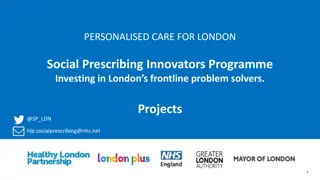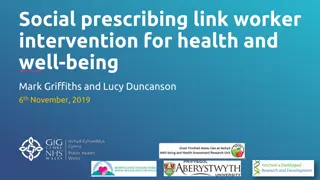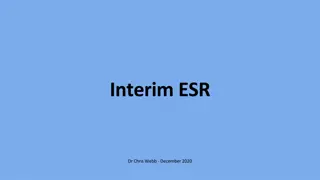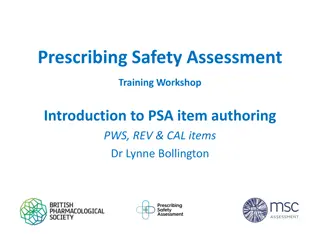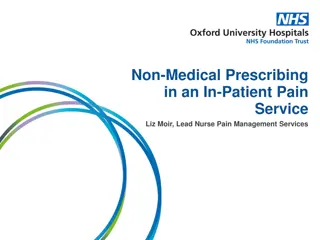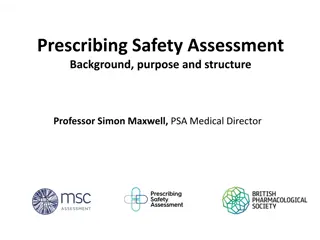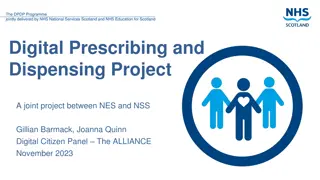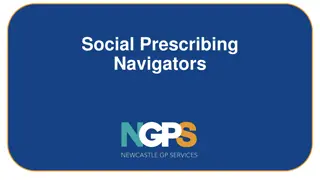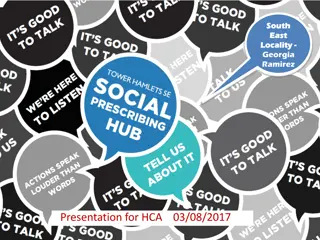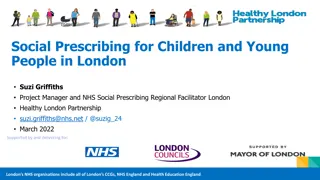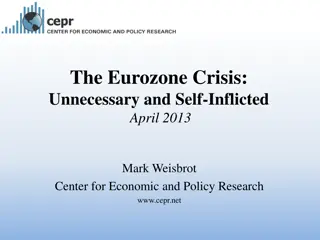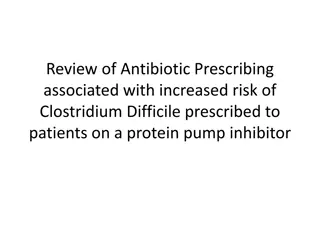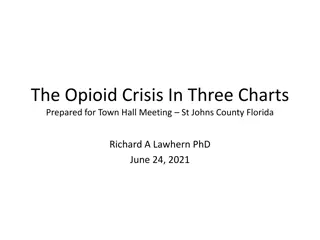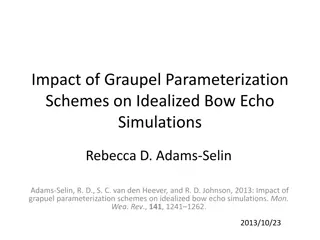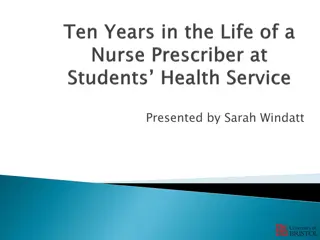Crisis Social Prescribing at Bromley by Bow: Interim Report on Reach and Impact
The Bromley by Bow Health Partnership and Centre are providing innovative health and well-being services in East London, focusing on the diverse needs of their community. Amid the pandemic, they adapted their Crisis Social Prescribing initiative to offer support to vulnerable individuals through various interventions. The report outlines the reach, strengths, needs, interventions, and outcomes of their efforts during the challenging times.
Download Presentation

Please find below an Image/Link to download the presentation.
The content on the website is provided AS IS for your information and personal use only. It may not be sold, licensed, or shared on other websites without obtaining consent from the author. Download presentation by click this link. If you encounter any issues during the download, it is possible that the publisher has removed the file from their server.
E N D
Presentation Transcript
Crisis Social Prescribing at Bromley by Bow Interim report on reach and impact: Calls made between March 25th June 3rd Date: June 5th 2020 Authors: Sophie Imber, CR Stocks-Rankin and Emma Owen-Amadasun
Introduction The Bromley by Bow Health Partnership and Bromley by Bow Centre are a pioneering health and well-being outfit in the heart of East London, delivering services to one of London s most deprived areas. The Partnership provides primary health care services to more than 30000 registered patients, which accounts for approximately 10% of the Borough of Tower Hamlets population. The partnership is located across three different general practices, and has been established for over 30 years. The Bromley by Bow Centre is an internationally recognised charity supporting thousands of clients each year in a range of aspects from gardening to getting online. Through a range of experiences we have developed an approach to caring for local communities that understands the diverse and changing needs of populations, and inherently takes into consideration the broader social determinants of health. Together, we are the home of break through interventions such as Healthy Living Centres, Social Prescribing, DIY Health and Public Health England s flagship embedded research project, Unleashing Healthy Communities. 2
Introduction As the pandemic worsened and lockdown measures were introduced, The Bromley by Bow Health Partnership and Centre wanted to adapt and implement support for local people that would meet the changing and growing needs of our community in the most holistic way possible. The aim of our Crisis Social Prescribing work was to contact those who needed support and connect them to a range of initiatives from foodbanks, to legal aid, befriending and online activities. What did we do? Pooled staff together from various teams across the Health Partnership and Centre to make one team of Crisis Social Prescribers . Proactively identify cohorts of patients who we believed would be at additional risk of social and economic vulnerability due to lock down measures, including but reaching beyond those who were identified as Extremely Medically Vulnerable (shielding). We encouraged referrals for those in need of social, emotional and practical support, introducing a faster turn around for immediate issues. Implemented telephone-based support, signposted and referred patients and offered and delivered Home Packs to help people navigate and manage during the lock down period. 3
Aim: Share data and insight on our crisis response to Covid-19 This slidedeck includes: 1. The reach of Crisis Social Prescribing Service 2. The strengths, as well as the needs, of people who we have reached through this service. 3. The interventions we have offered people. 4. The reactions and outcomes to these interventions. 5. Methodology for analysis and learning. 4
Who have we spoken to? Reach of the Crisis Social Prescribing Service
Who are we speaking to? Breakdown: 512 704 BBBHP Vulnerable Patients St Andrews Shielded Total number of people spoken to to date Total number of calls made to date BBB Shielded TOTAL Total number of people spoken to Total number of calls made 256 120 136 512 448 120 136 704 9-90 Age range of patients spoken to 54 299 F : 221 M Total gender ratio Total average age of patients 6
Average calls made by team per week Example week 1 27-Apr 28-Apr 29-Apr 30-Apr 01-May 1 8 8 3 1 23 0 4 4 Average no. calls (initial contact) Average no. calls (callbacks) 10 Example week 2 04-May 05-May 06-May 08-May 07-May 5 1 1 6 7 5 9 4 0 0 Average no. calls (initial contact) Average no. calls (callbacks) Example week 3 11-May 12-May 13-May 14-May 15-May 4 5 4 6 2 2 16 2 5 8 Average no. calls (initial contact) Average no. calls (callbacks) 7
Where have we been referring people? Top services the team have been making referrals to (Total number of referrals = 249) Referral e.g. GoodSam / food banks BBBHP Homepack delivery Government support GoodSam (food) 3 Friends Mutual Aid BBBC Services (Active Together, CDC Photography, Chatter Matters Whatsapp Group) Family Playrooms Samaritans Number Reason for referral 106Feeling down, wanting additional ideas of things to do, keeping family entertained 40Council isolation form, completed online vulnerable form, requested gov food package 14Patients worried about shopping, low on shopping supplies as cant leave the house 11supporting letter for friend to do shopping, shopping for elderly 10shopping / medication pick-up, donating books Weight concerns, wanting advice on how to keep occuiped during the day, feeling isolated 9Keeping families with young children entertained 8Patients feeling anxious and low, suicidal thoughts 10 Patient had no food and no money to pay mutual aid groups for food, patients self- isolating and short on supplies First Love Foodbank GoodSam (medical) Tower Hamlets money service/Advice team BBBC Legal Advice team MIND GoodSam (regular chat) 5 5Buying specific nappy brand, hospital appointment, pick up medication 5Worriedd about paying bills, referral for rent arrears, housing support 4Advice on housing application (homeless patient), temporary accomodation and rights 3Mental health support anxious since wife returned to hospital 3Feeling isolated No food in the house (filled out LBTH form), unable to access money due to card being blocked Local foodbank 3 GoodSam (other) Social prescribing 2Reasons not specified 2Victim of domestic violence Patient can't afford to stay at home so went back to work. He can't read or write and works as a cleaner at Stratford International. He has not been given gloves or any other protection until this morning. 1Support for elderly 1Patient wanting extra help to support wife 1Patient at risk of being made homeless (domestic incident) 1Hot meal delivery 1Food package delivery 1Stress and anxiety ACAS Silverline AgeUk East London Tower Hamlets housing support Neighbours Poplar Carers Centre Talking Therapies 1 9
How have we mapped the needs and the strengths of our community? Outcomes Framework Outcome Definition Basic needs This outcome is about to helping us to address the most urgent issues that are affecting our life. E.g. access to services, Health (physical and mental health), money and getting a job Connected to others This outcome describes what happens when we meet new people and build relationships. E.g. supportive relationships Built knowledge, skills and opportunity This outcome is about connecting to our existing resources, knowing where to go and how to access learning opportunities and developing our knowledge and skills. E.g. knowing about new opportunities, learning new things Personal resources This outcome is about how we feel in ourselves and what these inner resources help us to do in the world around us. E.g. wellbeing, confidence, resilience Connected to a place or community Connection in to place or community works in three ways: feeling known and trusting people, shaping community and place, and having a sense of belonging. This outcome is about your relationship to a physical place and/or your relationship to a group of people. Contributed This outcome describes what happens when we re able to offer our talents and assets in a way that is meaningful to ourselves and others and when we re able to take action for ourselves. 1 0
STRENGTHS AND NEEDS OF OUR COMMUNITY BBBHP Vulnerable Patients St Andrews Shielded BBB Shielded STRENGTHS AND NEEDS Basic needs 155 55 28 Connected to others 94 20 6 Built knowledge, skills and opportunity Personal resources Connected to place and community Contributed 36 76 77 60 14 3 23 14 0 10 0 1 1 1
BBBHP Vulnerable Patients Deep dive
Strengths and needs of our community 1 3
Basic needs Health (Coronavirus symptoms); 4% Health (LTCs); 5% THEMES TOTAL NUMBER Financial Health; 9% Access to food; 37% Access to food 57 Health (Other) 28 Access to medication supplies; 13% Home/Environment 22 Access to medication supplies 20 Financial Health 13 Health (LTCs) 8 Health (Coronavirus symptoms) 6 Home/Environment; 14% Health (Other); 18% 14
Connected to Others Bereavement; 3% THEMES TOTAL NUMBER 74 at least one callback with recorded data (32 people have had at least 4 callbacks after initial call) Family relationships; 12% Developing new relationships with BBB model Feeling isolated Strengthening existing relationships Family relationships Bereavement Strengthening existing relationships; 12% 15 14 14 4 Developing new relationships with BBB model; 61% Feeling isolated; 12% 15
Built knowledge, skills and opportunity Utilising skills; 4% Learning basic skills; 4% THEMES TOTAL NUMBER Learning about new opportunities; 18% Accessing guidance/information Learning about new opportunities Learning basic skills Utilising skills 17 4 1 1 Accessing guidance/information; 74% 16
Personal resources Patients showing resilience 6% Feeling in control 6% THEMES TOTAL NUMBER Patients feeling low/anxious General wellbeing Feeling in control Patients showing resilience 35 11 3 General wellbeing 21% 3 Patients feeling low/anxious 67% 17
Connected to a place or community Connection to outside space 4% Feeling known 1% THEMES TOTAL NUMBER Connection to the wider community 74 Connection to outside space Feeling known 3 1 Connection to the wider community 95% 18
Contributed THEMES Understanding what you can offer / Giving back to the community TOTAL NUMBER 8 Examples Patients wanting to get creative / get involved in groups / iused to enjoy creative activites Patients reporting they would like to get involved with groups when Covid is over. Patients wanting to create pieces for practice Understanding what you can offer / Giving back to the community 19
Interventions to work with people s strengths and needs 2 0
Interventions Health literacy Signposting to other services and supports Ensuring people have the right information Support to fill out forms/receive shielding letter Ordering medication Receive home-pack Helping people with immediate needs Emotional support and listening ear Call backs to ensure people are safe and well Empowering people to connect to their existing strengths Tasks offered to people to help them keep busy Emotional and psychosocial support To BBB services To Council support To other community supports To social prescribing Referral 21
Interventions needed w.b. 27th April (out of a total of 64 calls) NUMBER TYPE OF INTERVENTION 8 Health literacy Ensuring people have the right information No Intervention needed i.e. people are okay and coping well = 7 Signposting to other services and supports e.g. to GP 6 5 Support to fill out forms/receive shielding letter e.g. vulnerable form, council food form 1 Ordering medication Helping people with immediate needs Receive home-pack 19 24 Emotional support and listening ear Call backs to ensure people are safe and well (or taking number to call if needed) 23 Emotional and psychosocial support Empowering people to connect to their existing strengths e.g. encouraging people to paint for the practice 2 Tasks offered to people to help them keep busy 6 1 To BBB services e.g. Talking Therapies 3 To Council support e.g. money/housing advice, council grant scheme Referral To other community supports e.g. foodbanks/GoodSam/mutual aid 7 To social prescribing 2 22
Interventions In order to respond effectively to the needs of the community, the team at the Bromley by Bow Health Partnership have made a number of interventions that include, but are not limited to, the following: - Acting as a sounding board for a patient i.e. patients reporting that they wanted to offload from someone from the outside - Helping patients with immediate needs i.e. topping up mobile phone credit, helping to top up electric key - Signposting to community services e.g. GoodSam for shopping/medicine supplies, mutual aid groups - Befriending services - Signposting to charity services e.g. MIND, Samaritans, Silverline for further support - Referring to BBBC services e.g. exercise classes, mental health sessions, photography classes - Filling out extremely vulnerable government online form - Referrals to social prescribing - Referral to advice services / legal team for housing support, support with money issues and career guidance It is also important to note how thankful the community have been for these calls there has been a high number of callback requests to check in with patients weekly/fortnightly, and patients have been very grateful one patient commented that if it hadn t been for the call our team made she was worried that she would be forgotten about altogether . 23
Reactions and actions to these interventions 2 4
Reactions & Actions Most calls have focused on a person s need or strength. As a result, the majority of comments in the data give an indication of the person s context rather than their reaction to the call itself. Reactions to the call Frequency Stretch Outcomes for BBB 22 Connected to others Request for call back 3 Strengthened personal resources 5 Very positive/grateful Ambiguous response to call, e.g. patient put phone down during the call. Total number of reactions in data 30 Actions that people have taken after the call Action: Request for more info and resources Frequency Stretch Outcomes for BBB 11 Built knowledge, skills and opportunity 3 Connected to place and community 1 Basic need met Action: Attending new community groups Action: Problem resolved 15 Total number of actions in data 25
Needs over time 2 6
Different needs and strengths in a series of call backs Each call can raise different needs and different strengths. Some people start out feeling well and face challenges in subsequent calls. Others start with a series of challenges which are quickly resolved. And other people have a new challenge at each call. The call-backs seem to be responding well to the whatever is presented, whether that is a person s strengths or their need. Clear efforts to build on the strengths week on week and ensure urgent need is met. 27
Patient journey: Example 1 Patient 3 (Four calls in total) Daughter does shopping and basic needs are being met. Basic needs Misses human interaction of shopping, feeling a little low. Connected to others Cooking for oneself and using mobility gym, feeling a bit more positive. Personal resources Connected to place / community Personal resources Sat in the square with neighbours, pleased to be engaging with familiar things. Shared memories about husband and marriage, seems to be more grounded and doing well. For this patient, the journey of these four calls shows a mostly positive progression. After determining that basic needs we being met, the caller made additional calls that focused more on mental health and supporting the patient with the ups and downs of the lockdown experience. Feeling isolated eventually leads to being able to have a socially distanced gathering. 28
Patient journey: Example 2 Patient 10 (Four calls in total) Reconnected with family and felt positively Connected to others Talked with caller about keeping 'mentally well' and good hygiene during the pandemic Personal resources High anxiety as a result of stress in new family reconnections / Caller used breathing techniques to calm Basic needs Caller to speak to on-call GP about patient s mental health after high levels of anxiety displayed Basic needs For this patient, the journey of these four calls shows a positive starting point and optimism after being reconnected with family. After some grounding conversations with the caller to talk about coping strategies, the conversation in the later calls take downward turn. High levels of anxiety is expressed and the caller links into a GP for more immediate clinical support. 29
Methodology 1. Learnt the BBB Outcomes Framework: Read resources produced by the Unleashing Healthy Communities project to understandeach of the six core stretch outcomes in order to apply that framework to the Crisis Social Prescribing data. 2. Operationalised Outcomes Framework: Developed codes and sub-codes for each outcome and applied these to the needs/strengths data that was being captured from each call. 3. Build analysis into service spreadsheet: Worked with the existing spreadsheet used by the staff team to capture their calls. Added in columns to code, and sub- code, each comment that staff make about their calls. 4. Developed weekly routine to analysis data and support team learning: Worked with the team s workflow to ensure that learning was shared on Monday with plenty of time for the team to read and digest the information by Thursday s team meeting. Concentrated analysis on Fridays and Mondays to harmonise with team workflow. 5. Reflected on learning and captured challenges: Captured challenges with coding throughout process. Worked with colleagues to reflect on methodology. Documented process so other services can follow methodology and apply outcomes framework. 31
Workflow of researcher 1. Quantify number of calls and demographic details: Analysis of calls per week in terms of number, age and demographics of person who was called. 2. Initial coding: Read comments section of calls spreadsheet and code each call according to the six core strengths/needs in the BBB Outcomes Framework, e.g. basic needs, personal resources, etc. 3. Sub-analysis of each code: Conduct a sub-analysis of each of the six core strengths/needs to understand the deeper issue, e.g. basic needs may refer to food, an urgent mental health issue, etc. 4. Referral analysis: Analysis of organisations/groups/services that Callers have referred people onto. 5. Produce report: Refine and condense information into a slidedeck. Pull out a key story for the staff team each week to highlight themes and efforts made by staff. Total time commitment: Approximately 2.5 days/week 32
Challenges and learning 1. What is the difference between personal resources and built knowledge, skills and opportunity ? Decision that the coding of personal resources refers more to a person s internal resources such as mood, memory, resilience and drive. The code for built knowledge, skills and opportunity refers more to external acquisition of knowledge and information, skills and opportunities. 2. What is the difference between connect to others and connected to place and community ? Decision that coding of connected to others refers to connection to services and supports, family members and friends. In contrast, connected to place and and community refers more to being connected to neighbours, gardens, local green space, and other local assets such as cafes. Some ambiguity about where family fits connected to others and connected to community both work. Likewise, Mutual Aid Groups could fit in both codes. 3. Limited outcome data Calls focused on people s context, the strengths and their needs. The BBB Outcomes Frmk was used to categorize these strengths and needs. But at present, there is a limited amount of outcomes data to analyse with the framework as the intervention is too new to have had a lasting effect. 4. Strength and need captured simultaneously Comments from social prescribers focus on positive and negative elements of a person s life their struggle and their strength. Data analysis mirrored this focus and coded positive and negative comments according to the six outcomes of the framework. As such, there is no current sub-analysis of needs vs strengths. 33
Basic needs - Examples Patients in need of shopping supplies Patients worried about shopping Patient unable to do her shopping and worried about passing Covid to family Patients with difficulties getting online delivery slots Worries about food - patients that have no food / hot meals Low income -> no food Issues with food supplies, gone days without eating Patient wants supporting letter for friend to go shopping Patients reporting weight concerns (putting on weight/being underweight Patients reporting difficulties sleeping ne patient stopped taking one of her regular medication as believes this will reduce immune function and is in fear of catching Covid Patients reporting recovering from spinal surgery/brain injury/collapsed lung Reporting urine infection Reporting pain due to multiple hospital appointments cancelled Sleep apnea (one patient) Kidney transplant (one patient) Patient wanted help with requesting/re-ordering/picking up medication Patients who are scared to leave the house - haven't left in weeks People feeling restricted whilst being at home Patients who have been made homeless and currently living in temporary accommodation Patients who have been made homeless and seeking support with housing applications Patients as victims of domestic abuse Patients living in crowded housing Patients having family issues and wanting to move out Patients lack money for food supplies, anxiety around paying bills One patient victim of financial abuse Work environment - patient unable to stop working - no gloves or PPE provided Patients off work due to Covid symptoms/wanting to go back to work after having symptoms Patients having trouble with phone credit/energy key top-up Concerns around whether it is safe to return to work when living with sheltering family member Anxiety around not paying bills on time/whether benefits are enough to cover bills Patients managing LTCS e.g. chronic pain, COPD, cancer patients, diabetes, ashthma, arthritis Patients recovering from Covid symptoms e.g. pneuomina, cough Access to food Health (Other) Access to medication supplies Home/Environment Financial Health Health (LTCs) Health (Covid)
Connected to Others - Examples Developing new relationships with BBBHP Patients wanting to offload / speak to someone from the 'outside' / wants a check-in call Patients lviing alone who feel isolated and lonely Lack of family visits (as they are unable to) causing low mood Lack of support network - rarely sees family members and has no trustworthy friends Patients feeling socially isolated Feeling isolated Patient worried about keeping in touch with friends/family online Patients caring for sick neighbours / family members Parents who are enjoying spending lots more time with children Carers: reports of carers reducing visits since lockdown, one person wanted his carer to move in with him and employ directly Strengthening existing relationships Patients wanting help to keep children occupied Parents concerned about childrens health Parents anxious to take children outside Young mother who recently moved to London is missing family and feels very alone Patient who recently gave birth and was having an extremely difficult time Parents with autistic children struggling to cope/keep them entertained Husband struggling to cope after wife released from hospital Family relationships Patients wanting bereavement support from practice Multiple patients reported feeling low due to family member death one reported having some support from previous support worker but other support unclear Bereavement 36
Built knowledge, skills and opportunity - Examples People needed clarity to understand/access information on what to do if contract Coronavirus/show symptoms Clarity needed on shielding and importance of staying indoors (clarifying difference between self-isolation and shielding)- people going out when should be shielding Patient unsure what to do if contracted Coronovirus/has symptoms People needed help to connect to existing resources e.g. mutual aid whatsapp groups Accessing guidance/information Patients needed support in knowing where to go for help/being signposted/connected to services/mutual aid groups to meet needs Requesting homepacks for ideas as to how to keep busy Parents who do not read / write concerned about supporting childrens education People are making use of existing skills through cooking/reading/gardening, but need some support with new ideas People are using skills to get creative e.g. making a lampshade Learning about new opportunities Learning basic skills Utilising skills 37
Personal resources - Examples Patient who cannot stop thinking about Covid and are very anxious Patient suffers with panic attacks / low mood / anxiety around Covid (think they have it/will pass it on/reading the news) Patients feeling low due to not being able to see family Patients reporting suicidal thoughts Patients with past history of depression and being used to not leaving the house Patients feeling low/anxious Patients lacking confidence to leave the house People struggling to pass the time / adapt to routine Patients need support with healthy eating/exercising Patients wanting to run errands/go out for walks to establish independence, despite guidelines to stay at home General wellbeing Feeling in control Patients keeping journals to help cope with anxiety Patients making effort to start exercising / healthy eating / keeping routine to improve mood Patient who sometimes feels anxious when he goes out shopping copes by using breathing techniques and putting headphones in when outside Patients showing resilience 38
Connected to place or community - Examples Patients missing the outside Patients are afraid of outside Patients enjoying spending time in parks/gardens Connection to outside space Patients being connected to and making use of community services e.g. Poplar Harca Neighbourhood, Stepney Green Jewish Centre etc. People participating in virtual sessions e.g. AA session, coffee afternoon and quizzes Connection to the wider community Strong sense that people feel the practice is thinking of patients and cares about them -> callbacks Feeling known 39




